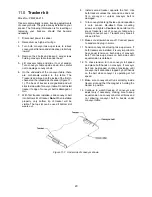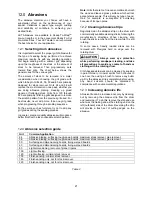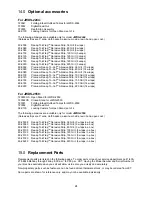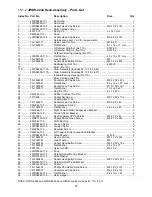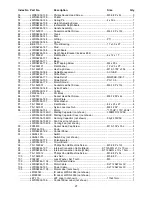
14
Figure 8-1
8.4
Infeed/Outfeed Table Adjustment
(OPTIONAL)
The optional tables can be swung down to allow
easier access for abrasive wrapping or other
adjustments.
Loosen handles on each side, slide table away from
machine and then down. See Figure 8-2.
Figure 8-2
8.5
Conveyor belt tension/tracking
Conveyor belt tension adjustment may be
necessary during the break-in period to compensate
for belt stretching.
8.5.1
Belt tension adjustment
1. Adjust take-up screw (Figure 8-3) with 5mm hex
wrench. Do this on both sides of conveyor to
obtain approximately equal tension on both
sides of conveyor belt when taut.
NOTE: Insufficient belt tension will cause
slippage of conveyor belt on drive roller during
sanding operation. The conveyor belt is too
loose if it can be stopped by hand pressure
applied directly to top of moving conveyor belt.
Excessive belt tension can result in bent rollers,
bent brackets, and/or premature wearing of
bushings or conveyor belt.
Figure 8-3: belt take-up screw
8.5.2
Belt tracking adjustment
A belt tracks correctly when it moves centrally on the
conveyor rollers without drifting to either side.
Tracking adjustments are made while conveyor belt
is running.
1. Make sure proper belt tension has been
achieved (see
sect. 8.5.1
).
2. Turn on conveyor and set to maximum speed.
Watch for tendency of conveyor belt to drift to
one side of conveyor. If it drifts, tighten or
loosen take-up screw on either side (Figure 8-
3).
Note:
Adjust take-up screw only 1/4 turn at a time.
Allow time for belt to react to adjustments before
proceeding further.
Avoid over-adjusting, as this may affect belt tension.
If tension is affected, it may become necessary to
use both take-up screws to accomplish tensioning
and tracking.
8.5.3
Trackers
The sander comes equipped with “Trackers”,
ceramic guides that reduce the amount of
adjustments needed to keep conveyor belt tracked
(centered) on conveyor table. These guides have a
magnetic backing to keep them in place. If a Tracker
wears through, it can be reversed by turning it over.
See
sect. 11.0 Tracker Kit
for more information
about re-setting trackers.
8.6
Inspecting drum alignment
The sanding drum must be parallel to conveyor table
for proper machine operation. The sanding drum
comes pre-aligned from the manufacturer. If a
problem with drum alignment should occur, follow
the instructions below.
First, inspect the alignment with a gauge of some
kind. The following procedure uses a steel straight-
edge as a gauge.
1. Unplug sander from power source.




















